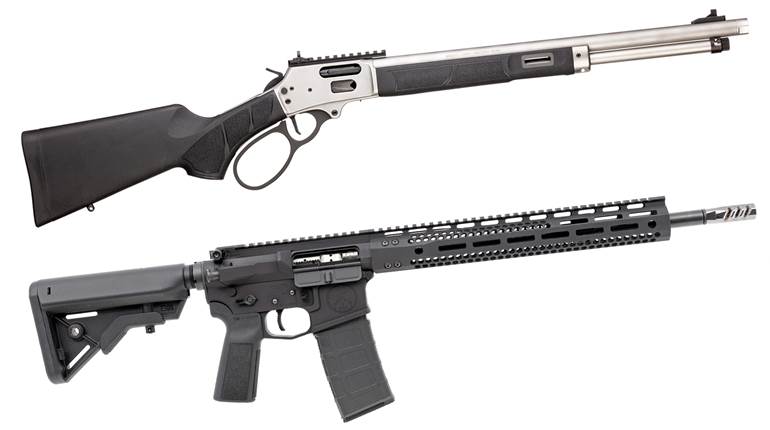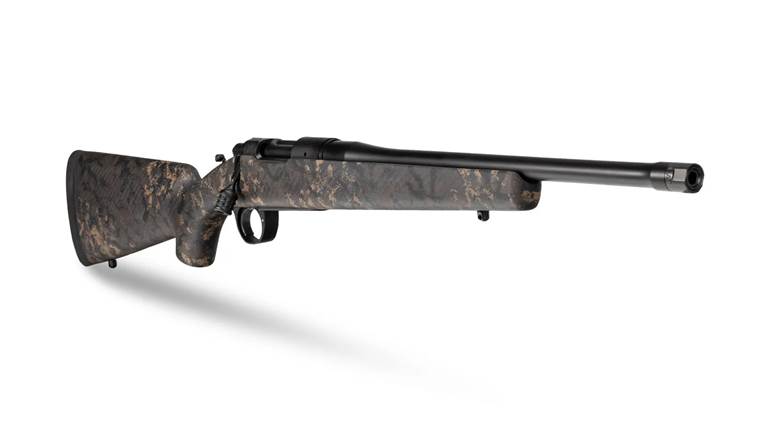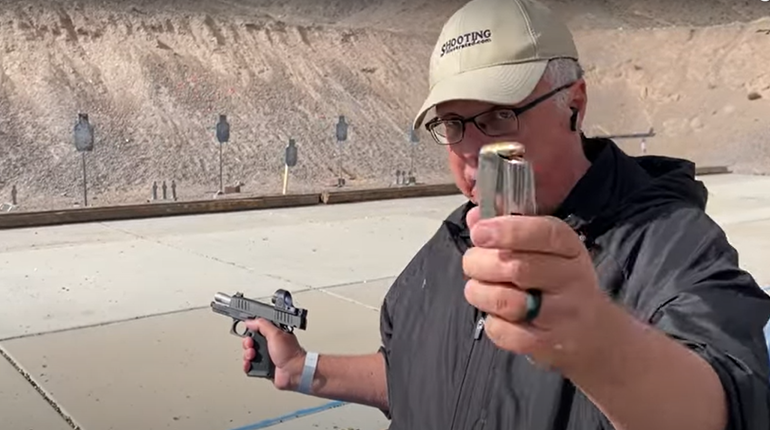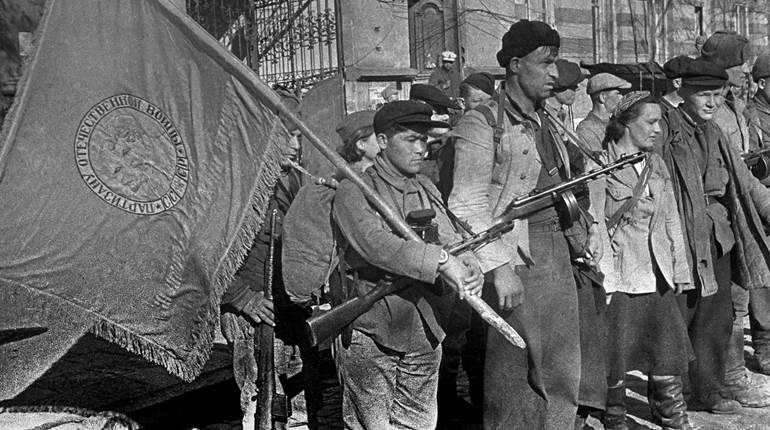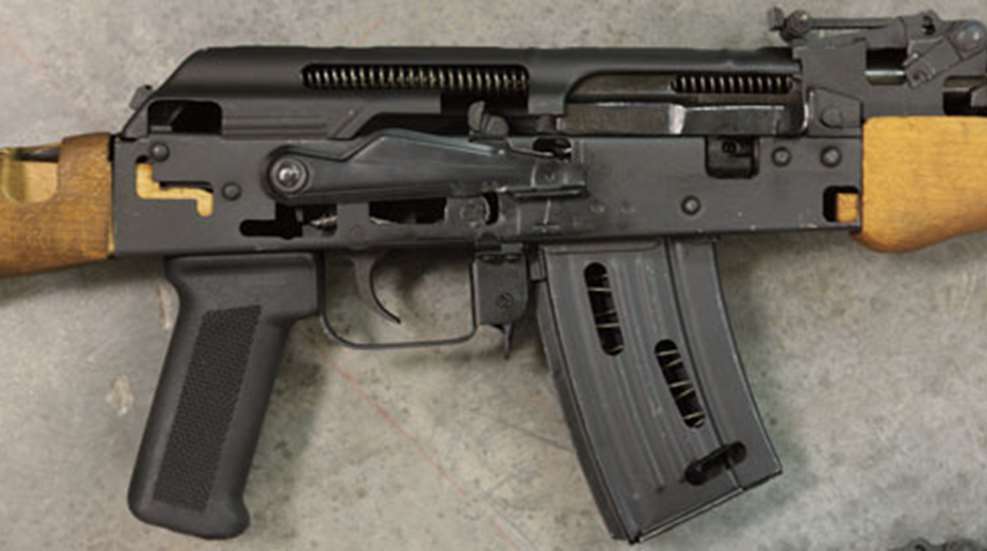
Sweet Mother Mary, that hurts. My finger is pulsating with pain, sharp excruciating stabs of agony as I learn one of the many lessons of how to handle select foreign arms, not all of which are nearly so painful. But what is imprinted forever in my brain is this: If you disassemble a Soviet DShK heavy machine gun, don’t let the feed cover fall on your finger!
“Get you, did it?” instructor Matt Babb asks with a devilish grin. “I told you to keep that cover locked back.” Like all hard-bitten old salts, Babb seems to take a secret sadistic pleasure in seeing one of his students dance around holding his finger, thereby proving his keep-the-cover-locked point.
Of course this is nothing compared to what would happen if I put my hand in the path of the big gun’s recoil spring tube. “Digits will fly!” Babb says menacingly. “Do not put your hand anywhere near the barrel when you release the bolt!”
The DShK is pronounced “Dushka,” which means “sweetie” in Russian, an ironic nickname. The Dushka is not sweet. It’s a heavy, ungainly, massive hunk of Russian steel. It fires the 12.7x109 mm cartridge, the Communist Bloc equivalent of our .50 BMG, and it’s one of more than a dozen foreign military arms I’ve set about studying at Long Mountain Outfitters in Henderson, Nev., during a five-day class focusing on the firearms that our troops are currently encountering in Iraq and Afghanistan.
Eight of the 11 students in my class are from the Army’s Picatinny Arsenal in New Jersey: four mechanical engineers, two ammunition specialists and a pair of Army and Marine veterans, who for all the world look like they’re twins from different mothers. Still sporting regulation haircuts, Tom and Alan are barrel-chested senior NCOs (retired) who handle the real-world test firing of small arms in the ARDEC division of Picatinny. They allow the engineers about a half-inch of slack.
We’re here to learn everything about the guns of the Gulf. I expect to see various AK-47s and maybe some SKSs, but I’m mildly surprised when class starts with Mosin-Nagant bolt-action rifles. Yes, there are still a lot of old World War I-era bolt-action rifles floating around in the hinterlands of the sandbox.
“The Mosin-Nagant is a Russian service rifle that fires the longest-serving military cartridge in the world,” Babb, a military small arms expert and gunsmith, tells us. “The 7.62x54 mm R is over 100 years old and it’s still in service in guns like the PKM, which we’ll see later in class.”
Babb shows us how to function check a rifle, a fundamental test that he will demand we perform on every arm we subsequently cover. “Always start with a function check, always end with a function check,” he instructs us.
“It’s a very Russian rifle,” Babb says of the Mosin-Nagant. “Simple. Brutally simple. It’s made for peasants, by peasants. Russian military doctrine was to arm as many conscripts as possible with as little training as possible, so their guns are basic.”
We next move to the French MAS 36, another bolt-action firing a 7.5x54 mm (French) cartridge. The variant we take apart comes with a rifle grenade launcher. The gun has a spike-shaped bayonet in the stock, under the barrel where you normally find a cleaning rod.
From France we cross the channel to England and the Short, Magazine Lee-Enfield (SMLE). The Brits are prone to over-engineering, like the Germans, and we find that the SMLE is enormously complicated compared to the MAS or the Mosin-Nagant. Babb shows us how to remove the detachable box magazine, but tells us that British troops were not issued replacements. “You didn’t change magazines to reload as you’d think. You reloaded the one that came with the rifle,” he said.
“The cock-on-closing of the Lee-Enfield is very fast once you get used to it,” he added. “The Germans often thought they were up against a machine gun when in fact it was just a company of Limeys who knew how to work their Lee-Enfields. They’re very fast.”
The legendary Mauser 98 is another old warhorse encountered in theater, so we learn how to fieldstrip it. The bolt is a marvel of design with its controlled-round feeding handled by its massive claw extractor. “The Mauser is still a good, solid weapon system,” Babb opines. I notice he refers to every firearm in the parlance of the military as a “weapon system.”
8/13/10
The famous Russian arms designer Sergey Simonov developed the Samozaryadnyj Karabin Simonova (Simonov Self-Loading Carbine), better known as the SKS, around the then-new 7.62x39 mm cartridge, which came about as part of the whole push for an intermediate “assault rifle” in the Great Patriotic War—what the rest of us call World War II. The SKS uses the Simonov locking system about which MattBabb is quick to point out, “Some people say this is a weak action.” He pauses for effect. “Folks, this is a miniaturized PTRS anti-tank rifle. It’s a plenty tough action.”
Each student disassembles his own SKS. I lift the take-down lever on the left side of the trunnion, I remove the gas piston and I see how it moves to impact a short-stroke connecting rod that in turn hits the bolt. Ingenious. I’m looking at a short-stroke gas piston system in its purest form. I will see more examples of the short-stroke system as the class progresses.
We detour from rifles to pistols, starting with a Tokarev. It’s reminiscent of an M1911 so I find myself at home as I remove the slide stop, take out a barrel bushing and expose a barrel with a Browning-style pivoting link. Babb tells us to remove the grips via an elegantly simple rotating lever inside the magazine well.
We now remove the trigger pack and disassemble it. And I thought it was hard to get the disconnector and sear back in the M1911. I finally get the Tokarev’s pesky hammer spring to stay in place while I reinsert a pin. I breathe a sign of relief as those ingenious grip panels snick back into place.
The Makarov is a Russian knock-off of the German PP or PPK/s. It’s a simple blowback-operated pistol (meaning it doesn’t have a locked breech), chambered for the 9x18 mm Makarov cartridge. Babb explains a feature on the Makarov that sheds light on a lot of other designs: the magazine release.
“Europeans want a heel-release because they feel that the magazine should be retained with the gun. They’re not into high-speed reloads and leaving mags all over the place,” he says. Another handgun found in the sandbox is the Beretta 951 or Iraqi Tariq pistol, an open-slide design that’s the progenitor of the current 92FS. Tomorrow will be big: We will tackle the AK-47.
8/13/10
The iconic AK-47 is not what you might have been led to think, Matt Babb says. “You’ve probably heard the spiel. Mikhail Kalashnikov, a brilliant arms designer, is convalescing in a hospital when inspiration strikes and he designs the AK-47. Folks, it didn’t happen like that. It wasn’t until his sixth prototype that Kalashnikov finally got it right. That was the ‘first’ AK-47. He himself admits that he looked at the M1 Garand as part of his inspiration for the weapon system.”
Having debunked part of the AK myth, Matt walks us through how to strip the gun and why it is such a brutally simple, typically Russian design. The top cover pops off easily, allowing you to remove the recoil spring, which is captive so it doesn’t fly across the room and hit the Picatinny guys. The bolt assembly comes right out with the gas piston attached. From there, you’re three pins away from having the trigger assembly apart. We’re taking apart a select-fire AK-47 since this is a military firearms class, so we see how the auto sear also serves as an out-of-battery safety to prevent the rifle from firing if the bolt isn’t fully closed. We remove the three pins and take out the hammer, sear, cyclic rate reducer, trigger and auto sear.
While reassembling the gun, Babb shows us a trick of how to use the cleaning rod as a slave pin to hold the wire spring down while the second of the three pins is reinserted. As the last student gets his AK top cover snapped on, Babb assumes the role of a drill instructor.
“Everyone got their gun back together? Good. Now take ’em apart again!”
The sound of bolts moving, springs sliding, metallic parts pinging, shlack-clacking apart reverberates.
“Got ’em apart? Put ’em back!”
“Do it again!”
“Put ’em back!”
“Do it again!”
We learn through the mother of all skill builders—repetition, repetition, repetition. After the fifth or sixth rep, the guns are coming apart and going back together with a fluidity born of familiarity.
We learn that the “P” on the rear sight, below the “1,” is the battle zero. We are shown why the AK doesn’t have timing issues because the bolt rotates a full 30 degrees before unlocking, giving the just-fired cartridge case time to relax in the chamber. We also see how the gun has a floating firing pin so you don’t get accidental strikes.
We watch a video of an AK firing in full-automatic in super-slow motion with the top cover removed. Don’t try this at home! The bolt is bouncing around, the piston is flexing wildly, and the recoil spring jumps like it’s been goosed.
“You see that? The AK is a sloppy gun. It’s supposed to be a sloppy gun. That’s why it works,” Babb points out.
Now we move to AK variants in a slide show. Matt points out that the AKM is a stamped-receiver gun. “The ‘M’ in any Russian designation means ‘modernized.’ So you have the AKM, PKM, and others,” Matt tells us. We see slides of East German variants with distinctive, side-folding stocks; Hungarian variants with an infinity symbol for full-automatic; Chinese Type 56s; a North Korean Type 68 and an Iraqi Tabuk. Babb says the best of them all is the Yugoslav variant known as the Zastava AK for the plant where it’s made.
He flicks the lights back on and surveys the room with that same secretly sadistic smile. We know what’s coming.
“Take ’em apart!”
“Put ’em back!”
8/13/10
Today we move to the belt-feds. First up is the PKM, which fires the same 7.62x54 mm R as the ancient Mosin-Nagant bolt-action rifle with which we started the class. The PKM is an air-cooled medium machine gun that fires from an open bolt. The feed belt is made from non-disintegrating links. The machine gunner is expected to reload his own gun.
“Russian doctrine on the PKM is that you don’t have an [assistant gunner]. You’re responsible for your gun. You carry it, you plop down, you feed it. You carry your own ammo,” Babb explains. “My two favorite machine guns are the M60 and the PKM. They just run and run and run,” he adds.
We side-track to a Dragunov, the so-called “sniper rifle” of the Com Bloc, but as we look at several variants of the gun we learn that it’s a five-minute rifle, meaning it shoots a 5-inch group at 100 yards.
“Once again, you see the difference in Soviet military doctrine. We think of snipers as precision shooters taking head shots on a specific target. The Russians simply want to put a bullet into a body. They don’t care what happens after that,” Matt says.
We move to the RPD, a light machine gun firing the 7.62x39 mm cartridge of the AK-47. It too uses non-disintegrating links, and is an open-bolt, air-cooled full-automatic-only machine gun. The bolt works with a Degtyarev locking system of two “ears” that pop out as the bolt closes and engage recesses in the receiver. It’s the same system as that massive brute, the Dushka.
We look at examples of the Skorpion, a .32 ACP machine pistol that Babb sniffs at. “Machine pistols are something that don’t have a lot of use. You pull it out, spray bullets and run away. Machine pistols have very little tactical relevance,” he says.
We gather around an AGS 17 automatic grenade launcher that hurls 30 mm grenades at a relatively sedate pace of 450 rounds per minute. “This is not a cheap date. This thing is heavy,” he says of the tripod-mounted monstrosity, adding with a grin, “I wish we had more time to discuss it instead of … Russian through it!”
The class groans at the painfully bad pun. Tomorrow we hit the range.
8/13/10
The classroom work is complete and today we test-fire some of the arms we’ve learned about. We start with the Tokarev and Makarov pistols. There’s a row of Bianchi plates, and some of us hit more than we miss. The Tokarev, with its bottleneck .30-cal. round, feels like a .38 Super in an M1911. The Makarov with its 9x18 mm in a blowback system feels like a stout .380 ACP. I hit more plates with the little Makarov for some reason.
Next up is the gun everyone loves to hate, the AK-47. We’re each given two 25-round magazines and told to fire a few rounds in semi-automatic before moving the selector to full-automatic. As I rip off a short burst, I feel the clackety-clack of all that flex and jump we’d seen in the slow-motion video. I hold the trigger back and lean into the gun, keeping the muzzle from climbing high and right. The longer the burst, the more I can feel the action slamming about. This is a crude gun, I think. Reliable, but crude.
Now the mats come out and an RPD belt-fed goes down on its bipod. This is the light machine gun firing the same 7.62x39 mm as the AK-47. We each get a 50-round belt. We’d already learned how the RPD, like all Soviet machine guns, uses a non-disintegrating metallic belt. Howard Heeg, LMO’s chief armorer, flips the top cover and shows me how to position the first round on the feed tray in the “ripper,” which pulls a round out of the belt. I slap the top cover down and flip the safety to fire. “Let ’er rip,” Heeg says.
I fire one short burst, feel how the gun is totally controllable, hardly moving on the bipod, and then I squeeze and hold the trigger in a long stream that churns the berm into a cloud of dust. The empty belt spits itself out. “Now that’s a good burst!” Heeg says enthusiastically.
We end with the PKM, a medium machine gun firing the antique 7.62x54 mm R cartridge, the same as the Mosin-Nagant bolt-action, c. 1891. While the round is essentially the same, the modern cartridge is stronger for reliability in machine guns. The PKM is awesome! It shoots smoothly and controllably and spits its rimmed empties out with alacrity. Of all the guns I’ve seen this week, this is the one I want to take home.
We wrap up with a presentation on the RPG 7 by Dan Shea, owner of Long Mountain Outfitters. Contrary to popular belief, RPG does not stand for “rocket-propelled grenade;” it’s a Russian acronym. It’s actually a recoilless rifle firing a rocket-assisted grenade (there’s a difference), which Dan explains along with much more arcane information about this curious weapon system, including how to sabotage one found on the battlefield to give our enemies a little surprise when they go to use it again.
I shake hands with the Picatinny guys, say goodbye to Babb and head past the vault. I’m struck with how much I’ve learned about foreign arms in the past week. Trust me, keep your fingers well-clear of the Dushka’s top cover.












